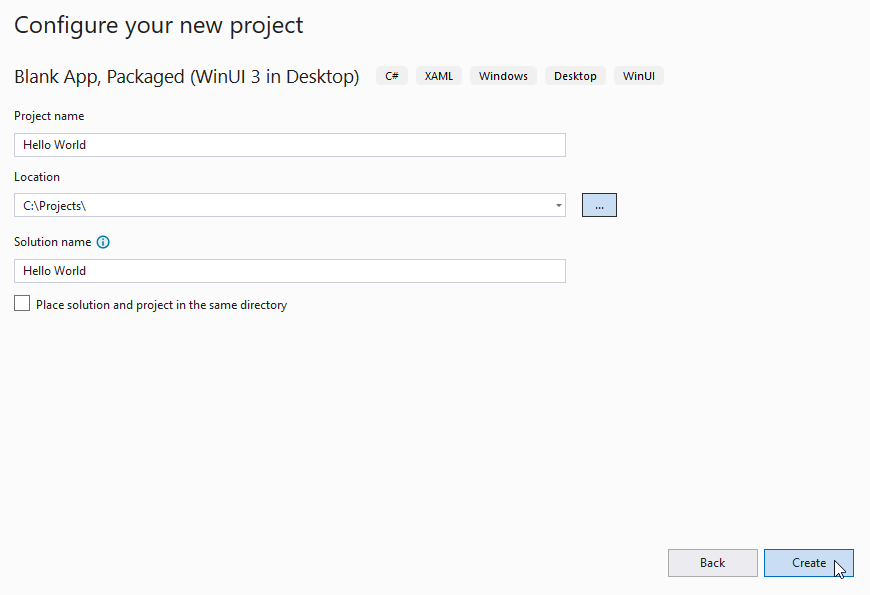Poznámka:
Přístup k této stránce vyžaduje autorizaci. Můžete se zkusit přihlásit nebo změnit adresáře.
Přístup k této stránce vyžaduje autorizaci. Můžete zkusit změnit adresáře.
Tento průvodce Hello World vás provede nastavením vývojového prostředí pro WinUI a Windows App SDK ve Visual Studiu a vytvořením první aplikace.
1. Povolení vývojářského režimu
Windows obsahuje vývojářský režim, který upravuje nastavení zabezpečení, abyste mohli spouštět a testovat aplikace, které vytváříte. Před sestavením, nasazením a testováním aplikace pomocí sady Visual Studio povolte vývojářský režim.
Spropitné
Pokud teď režim vývojáře nepovolíte, Visual Studio vás vyzve, abyste ho povolili při pokusu o sestavení aplikace.
Povolení vývojářského režimu:
- Otevřete Nastavení systému Windows a přejděte na stránku Upřesnit systém>.
- Přepněte přepínač Vývojářský režim na Zapnuto a potvrďte svou volbu v potvrzovacím dialogovém okně.
Další informace o vývojářském režimu najdete v tématu Nastavení pro vývojáře.
2. Instalace sady Visual Studio a požadovaných úloh pro WinUI a Sadu Windows App SDK
K vytváření, ladění a nasazování aplikací WinUI použijte Visual Studio, integrované vývojové prostředí Microsoftu. Visual Studio obsahuje šablony projektů připravené k použití pro Windows, které vám pomůžou rychle začít.
Bezplatná edice Visual Studio Community zahrnuje vše, co potřebujete k vývoji aplikací. Edice Professional a Enterprise jsou k dispozici pro větší týmy nebo organizace. Další podrobnosti najdete v tématu Co je Visual Studio? a požadavky na systém pro vývoj aplikací pro Windows.
Nainstalujte požadované nástroje a úlohy spuštěním jednoho z následujících příkazů v konzole.
Příkaz otevře instalační program sady Visual Studio s předem vybranými chybějícími úlohami – vyberte možnost Upravit a nainstalujte je.
Komunitní edici můžete nahradit edicí Professional nebo Enterprise a nainstalovat tak jinou verzi sady Visual Studio.
Vývoj aplikací v C#
winget install "Visual Studio Community 2022" --override "--add Microsoft.VisualStudio.Workload.ManagedDesktop Microsoft.VisualStudio.ComponentGroup.WindowsAppSDK.Cs" -s msstore
Vývoj aplikací v jazyce C++
winget install "Visual Studio Community 2022" --override "--add Microsoft.VisualStudio.Workload.NativeDesktop Microsoft.VisualStudio.ComponentGroup.WindowsAppSDK.Cpp" -s msstore
3. Vytvoření a spuštění první aplikace WinUI
Šablony projektů sady Visual Studio zahrnují všechno, co potřebujete k rychlému vytvoření aplikace. Když vytvoříte projekt ze šablony aplikace WinUI, začnete spustitelnou aplikací, kterou můžete rozšířit vlastním kódem.
Vytvoření nového projektu pomocí šablony projektu Prázdné aplikace WinUI C# :
Otevřete Visual Studio a na úvodní stránce vyberte Vytvořit nový projekt . Pokud je sada Visual Studio již otevřená, vyberte Soubor>nový>projekt.

Vyhledejte WinUI, vyberte šablonu projektu WinUI Blank App (Zabalená) v jazyce C# a pak vyberte Další.

Zadejte název projektu a pak vyberte Vytvořit. Volitelně můžete zadat název řešení a adresář nebo ponechat výchozí hodnoty. Na tomto obrázku
Hello Worldprojekt patří doHello Worldřešení, které je umístěno vC:\Projects\:
Stisknutím tlačítka Start sestavte a spusťte projekt:

Projekt se sestaví, nasadí na místní počítač a spustí se v režimu ladění:

Blahopřejeme, právě jste vytvořili svou první aplikaci WinUI!
Další kroky
Pokud chcete získat představu o tom, co WinUI nabízí, podívejte se na aplikaci Galerie WinUI.
Aplikace Galerie WinUI 3 obsahuje interaktivní příklady většiny ovládacích prvků, funkcí a funkcí WinUI 3. Získejte aplikaci z
Microsoft Storu nebo získejte zdrojový kód na GitHubu. Prozkoumejte principy fluent designu .
Najděte ukázky a nástroje , které vám pomůžou efektivněji vyvíjet aplikace.
Windows developer

